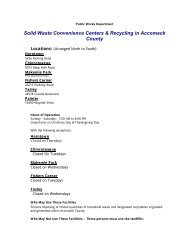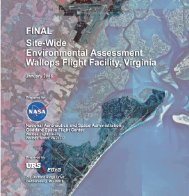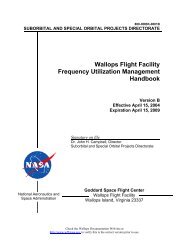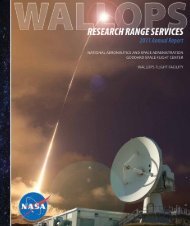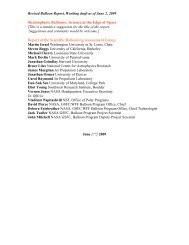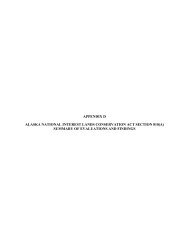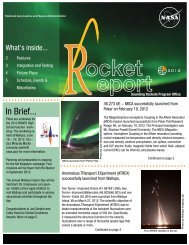Alternative Energy Draft EA - NASA Visitor Center at Wallops Flight ...
Alternative Energy Draft EA - NASA Visitor Center at Wallops Flight ...
Alternative Energy Draft EA - NASA Visitor Center at Wallops Flight ...
Create successful ePaper yourself
Turn your PDF publications into a flip-book with our unique Google optimized e-Paper software.
Mitig<strong>at</strong>ion and Monitoring<br />
5. Condition of carcass (whole or partial, extent of injury and some measure of<br />
decomposition to estim<strong>at</strong>e time of de<strong>at</strong>h);<br />
6. Preliminary estim<strong>at</strong>e of days since de<strong>at</strong>h;<br />
7. Position of carcass (face-up/down, sprawled, balled up, etc);<br />
8. Species, age and sex, if determinable; and<br />
9. Substr<strong>at</strong>e conditions when found (marsh/w<strong>at</strong>er, short/long grass, dense fragmite<br />
cover).<br />
Searches would begin as close to sunrise as possible. To ensure personnel safety, searches not<br />
occur in high wind, extreme he<strong>at</strong>, rain, or foggy conditions. Carcasses found during the survey<br />
effort would be c<strong>at</strong>aloged and stored in a freezer. If observers cannot determine species type<br />
because partial bird or b<strong>at</strong> carcasses were found, USFWS, VDGIF, or other expert biologists<br />
would be contacted to assist in species identific<strong>at</strong>ion efforts. Where individual fe<strong>at</strong>hers, as<br />
opposed to carcasses or clumps of fe<strong>at</strong>hers (including fe<strong>at</strong>her tracts) are found, observers would<br />
note these but they would not be considered wind turbine f<strong>at</strong>alities. Any larger than expected<br />
f<strong>at</strong>ality events or evidence of rare, thre<strong>at</strong>ened, or endangered species would be reported to<br />
USFWS and VDGIF staff within 48 hours of the discovery.<br />
We<strong>at</strong>her conditions from the night (for night migrants) and day (for other birds) prior to the<br />
surveys will be collected from local and n<strong>at</strong>ional we<strong>at</strong>her d<strong>at</strong>abases, or from personal<br />
observ<strong>at</strong>ion <strong>at</strong> or near the site. If carcasses are found, descriptions of visibility conditions the<br />
night prior to the f<strong>at</strong>ality surveys would be investig<strong>at</strong>ed and reported, particularly inform<strong>at</strong>ion<br />
concerning percent cloud cover and the presence of fog or low cloud ceilings.<br />
5.2.1.2 Carcass Removal Trials<br />
Carcass removal by scavengers would be monitored using no less than 30 specimens per year<br />
and would be performed periodically throughout the survey season. Planted carcasses would<br />
include an equal assortment of small birds, large birds and b<strong>at</strong>s (or tailless mice, as b<strong>at</strong><br />
surrog<strong>at</strong>es). Carcasses would be fresh, inconspicuously marked, and would be placed in various<br />
ground cover types and <strong>at</strong> different turbine loc<strong>at</strong>ions. Carcasses would be monitored daily<br />
(during the first week) for removal and thereafter weekly until the carcass disappears. During<br />
carcass checks, the loc<strong>at</strong>ion and condition of the carcass would be recorded on standardized d<strong>at</strong>a<br />
sheets to document the degree of scavenging (e.g., wing missing, tail missing, head missing,<br />
breast e<strong>at</strong>en, etc.) over time. Incidental signs such as tracks or sc<strong>at</strong> adjacent to the carcasses<br />
would also be identified and documented.<br />
5.2.1.3 Searcher Efficiency Trials<br />
Individual searcher efficiency trials would be conducted periodically during the survey period.<br />
Marked carcasses of various sizes, taxa, and species will be placed without prior knowledge of<br />
the searcher <strong>at</strong> various loc<strong>at</strong>ions and in various ground cover types. A record of how many days<br />
it took for a carcass to be found would be noted.<br />
5.2.1.4 Searchable Area<br />
Bird and b<strong>at</strong> f<strong>at</strong>alities are expected to be found within a circle centered on the turbine, with a<br />
radius of 80 percent of the turbine height. To facilit<strong>at</strong>e searches along transects, the f<strong>at</strong>ality area<br />
151




